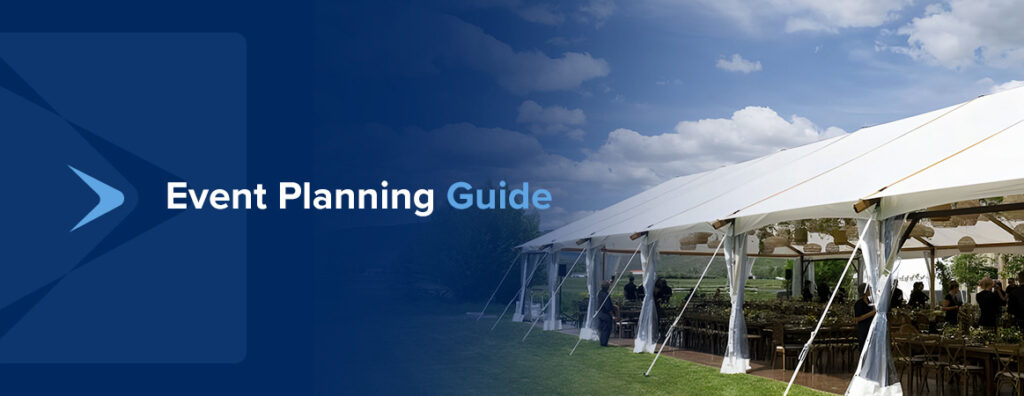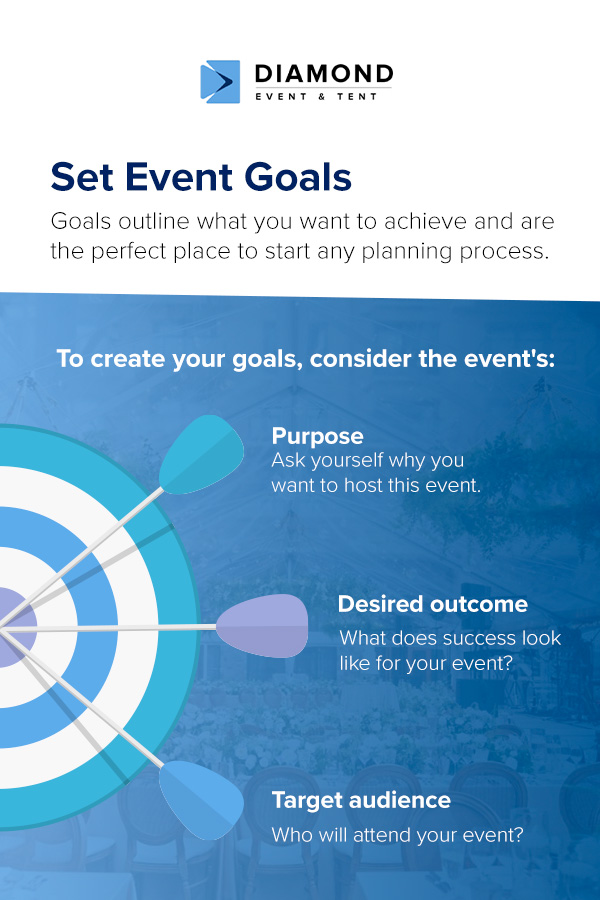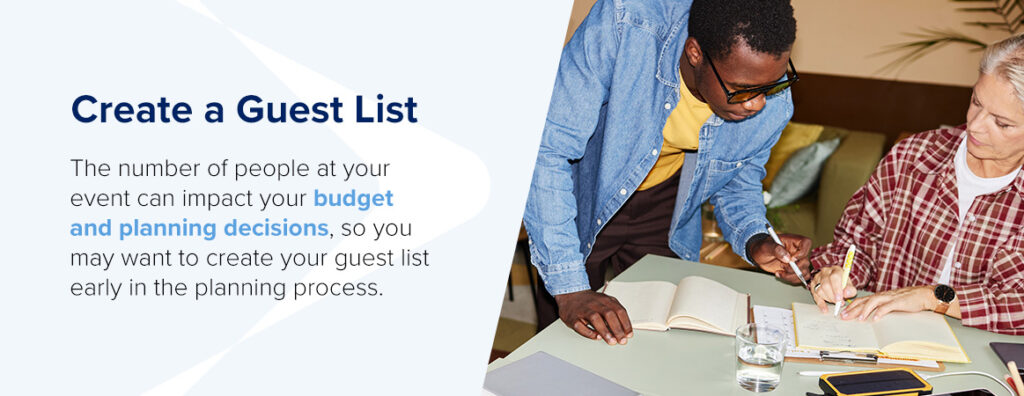
Planning an event can feel like a monumental task, but it’s more manageable when you have an event planning guide or template to work with. Successful event planning — whether for a party, wedding or corporate conference — relies on the coordination of various moving parts. You must organize budgets, venues, guests, vendors and more to ensure your event runs smoothly.
In this step-by-step event planning guide, you’ll learn how to plan a successful gathering. We’ve also included a free event planning checklist so you don’t forget anything in the planning chaos.
Follow the event planning steps below to set yourself up for a successful function. We’ve also included some event planning ideas for each part of the process to inspire you as you plan.

Goals outline what you want to achieve and are the perfect place to start any planning process. They’ll guide all your decisions and help you create an event that meets your expectations. Clear goals will also help you measure the success of your event when it’s over so you can learn and improve the next one.
To create your goals, consider the event’s:
Then, use the SMART framework to create more effective and concise goals. SMART stands for specific, measurable, achievable, relevant and time-based. An event planning example for a SMART goal could be to raise a specific amount of money for the outlined charity by the end of a fundraising event. For a wedding, you might consider a goal such as staying within the allocated budget for all wedding expenses.
Once you have your goals in mind, you can establish a budget to determine what you can afford and keep planning realistic. Your budget should outline your expected income and expenses related to the event. You might already have some money set aside, which you can use as the basis for your budget. Other events aim to generate revenue from ticket sales, merchandise or sponsorships.
Then, list all the potential expenses you’ll need to host a successful event. Each event is different, but most include the following basic expenses:
You can then determine your total cost by assigning values to each expense and adding them up. For more accurate predictions, research industry averages or base amounts on past events. Compare the costs to your expected revenue to ensure your event is profitable. If you’re working within a previously established budget, start with this amount and assign a percentage to each expense. Working within these percentages from the start can reduce the chance of overspending.
Remember to set aside some money in a contingency fund for unexpected costs. They’re bound to crop up, no matter how much you prepare!
Next, decide on the date of your event. The date is essential to the planning process as you’ll need it to determine the availability of attendees, venues and service providers. To find the best date for your event, factor in the following:

The number of people at your event can impact your budget and planning decisions, so you may want to create your guest list early in the planning process. If you know which people you want to invite, compile a list and arrange it according to priority. For personal events, you might consider close friends and family. Other event guest lists might include employees, donors, customers, industry leaders, subject matter experts or influencers.
Next, determine how many guests you can afford. A larger number of guests requires a bigger venue, which is often more expensive. You also need to consider catering costs if you want to feed everyone at your event. Once you choose a venue, you may have to reduce your guest list to fit within the maximum capacity. Consider your relationships with guests or their value to the event to help narrow the list down.
With your date, budget and guest list in mind, you can start hunting for a venue. Booking a venue early on is essential because venues can fill up quickly and attendees like to know where to go in advance. The perfect venue for your event depends on the type of gathering you’re hosting and what’s important to you. Some people may prioritize the event’s aesthetics, while others focus more on functionality.
Start your hunt by compiling a list of suitable venues in your target destination that fit within your budget. You can filter your list by comparing each venue’s capacity to your guest count. The venue should be big enough to accommodate everyone comfortably. It should also have enough parking for your guests and be accessible to people with disabilities.
A few other factors you can use to filter your list include:
Always visit your venue in person before making a final decision.
You can choose to plan a smaller event on your own. However, most people need extra help with planning a larger event like a wedding or conference. Consider the size of your event — if you’re inviting many people and have planned meals, entertainment or activities, you’ll likely need volunteers or hired staff.
An organized and capable team can greatly reduce the stress of planning and hosting an event. You can delegate tasks to them so everyone has something to focus on before and during the event. Create a list of all the tasks you must complete for your event and then assign a person to each one.
You can also consider hiring professionals to help you with some tasks, like:

An event schedule outlines everything that will happen on the day so you can better plan for it. Your schedule should include all the tasks your team needs to complete and the program for attendees. Plan your schedule by listing all the activities you want during your event. Give each activity a time estimation and organize them in order of priority. Remember to give activities more time than anticipated in case they run over.
Next, create the event program that you’ll distribute to attendees. Determine your event’s start and end time and then slot in each activity. When deciding on an order for activities, consider the flow of guests through the venue and guest energy levels. Guests should move smoothly through each activity or area and have time to rest.
Now, you can outline your event schedule. The schedule covers more than the program, as it’s what you’ll give your team so they know what to do and when. Event schedules often include details for arriving, making deliveries, setting up the venue, welcoming guests, serving food and packing up at the end. You can give the schedule to your team, staff, vendors and suppliers.
Once you know where your event will be and everything you want to happen, you can book vendors and suppliers. These professionals will help you accomplish everything during your event. Take a look at your event schedule and note all the tasks you need to complete. Then, decide which ones you and your team will do and which you need to outsource.
Most events hire vendors and suppliers for decor, furniture, catering, entertainment, security and transportation. You can request quotes from multiple people and compare them to save costs and find the best option. Before booking anyone, check with your venue to determine if it has limitations or restrictions you must abide by.
As you get closer to promoting your event and sending out invitations, you might consider how you brand or theme it. Most small social gatherings may not need branding, but a theme is a great way to coordinate decor and design. You can have a simple theme like pastel, disco, rustic or tropical for a wedding. Or, get creative with fun themes like pirates or woodland creatures for a kid’s party.
If you’re hosting a larger event like a festival, conference or seminar, consider creating both a theme and event branding. Branding refers to the event’s overall image and identity, including the name, logo, design elements and messaging. You can brand your event just like you would a business or product and use this branding in all promotional materials.
With all the details ironed out, it’s time to send out your event invites! These will let your guests know when the event is and what it entails so they can plan ahead. If you’re selling tickets or want to get as many people to attend as possible, you’ll need to do some event promotion.
Promoting your event is the process of spreading the word and generating excitement. The first step is to create an event website with all the information people need and a way to buy tickets. You can then promote your event through social media, online advertising, email newsletters and physical posters or billboards. Keep your branding and messaging consistent across every channel and direct people to your website.
Making a contingency plan is an important event planning guideline to follow. Contingency plans help event hosts overcome any unexpected changes that could disrupt the event and affect the attendee experience. Think rain, equipment failures, vendor cancellations or medical emergencies. Most event planners experience at least one thing that derails their plans, and it’s usually out of their control. Having a backup plan can reduce stress on the big day and keep your event going without a hitch.
It can be easy to forget something while planning an event. Make sure nothing gets overlooked with this handy social and corporate event planning checklist:
Planning and hosting an event can be difficult and stressful. If you’re feeling overwhelmed, consider working with Diamond Event & Tent. We’re the most well-known full-service event and party rental company in Salt Lake City and surrounding areas. Helping you host a successful event is our goal, and we’ll do everything we can to make that happen.
We can provide you with various rental equipment, including AV equipment, furniture, decor, lighting and flooring. We can also supply and install several types of event tents to protect attendees from the elements. Additionally, you can consult with our team if you need help planning your event.
Browse our rental catalog today and contact our team to get started!
© Diamond Event, Inc. | Built by Twelve Legs Marketing